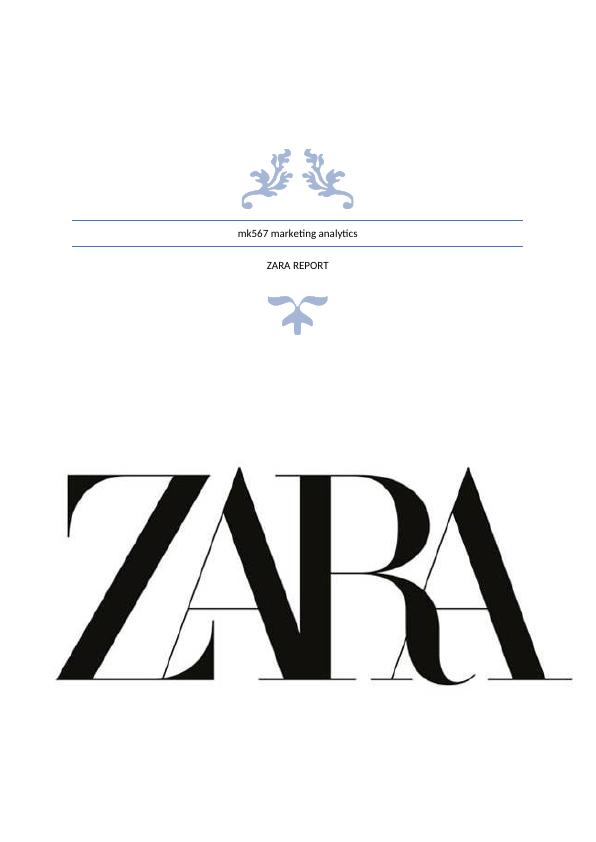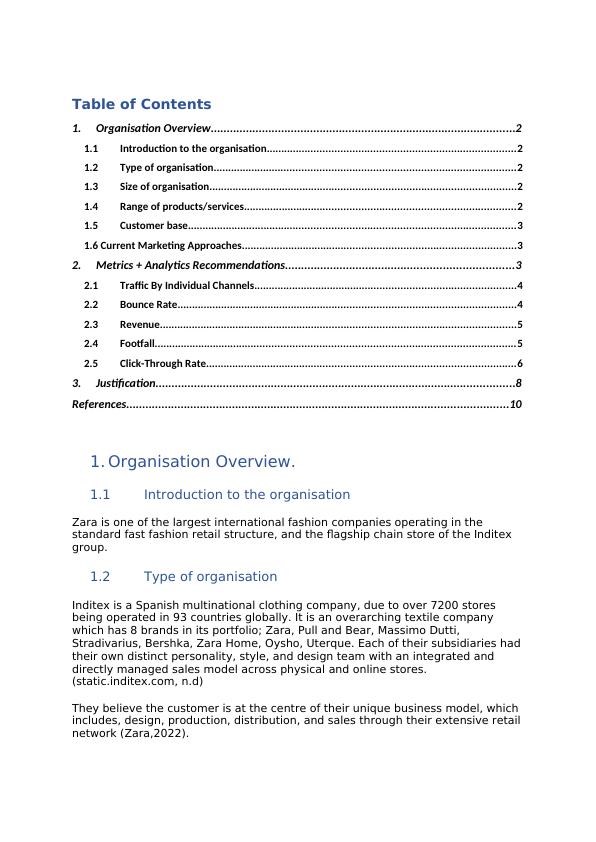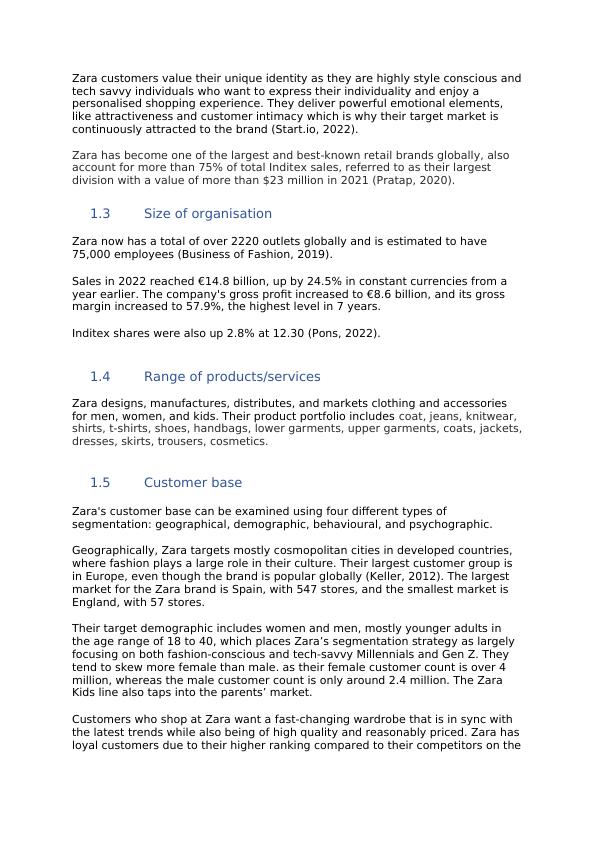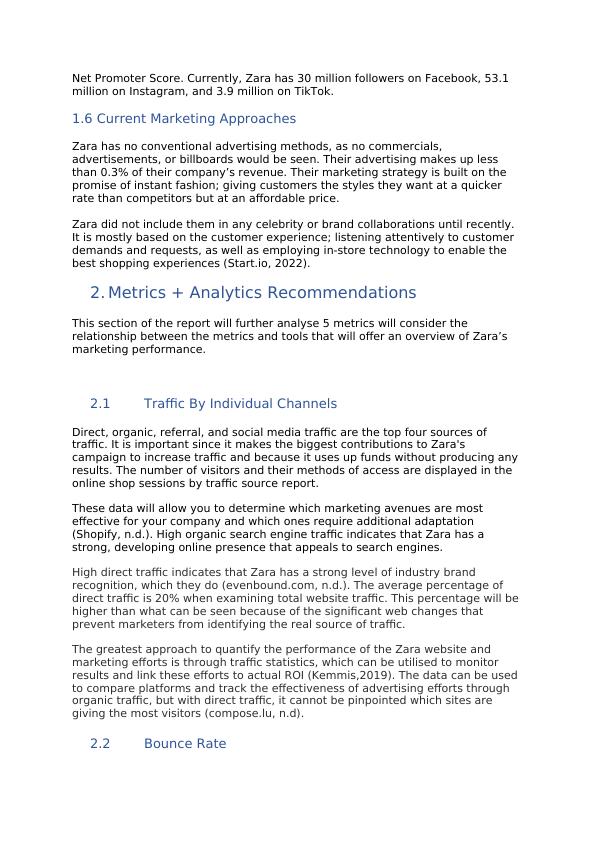(MK567) marketing analytics
Added on 2023-05-02
13 Pages4472 Words292 Views
mk567 marketing analytics
ZARA REPORT
ZARA REPORT

Table of Contents
1. Organisation Overview...............................................................................................2
1.1 Introduction to the organisation....................................................................................2
1.2 Type of organisation......................................................................................................2
1.3 Size of organisation........................................................................................................2
1.4 Range of products/services............................................................................................2
1.5 Customer base...............................................................................................................3
1.6 Current Marketing Approaches.............................................................................................3
2. Metrics + Analytics Recommendations.......................................................................3
2.1 Traffic By Individual Channels.........................................................................................4
2.2 Bounce Rate...................................................................................................................4
2.3 Revenue.........................................................................................................................5
2.4 Footfall..........................................................................................................................5
2.5 Click-Through Rate.........................................................................................................6
3. Justification................................................................................................................8
References.......................................................................................................................10
1. Organisation Overview.
1.1 Introduction to the organisation
Zara is one of the largest international fashion companies operating in the
standard fast fashion retail structure, and the flagship chain store of the Inditex
group.
1.2 Type of organisation
Inditex is a Spanish multinational clothing company, due to over 7200 stores
being operated in 93 countries globally. It is an overarching textile company
which has 8 brands in its portfolio; Zara, Pull and Bear, Massimo Dutti,
Stradivarius, Bershka, Zara Home, Oysho, Uterque. Each of their subsidiaries had
their own distinct personality, style, and design team with an integrated and
directly managed sales model across physical and online stores.
(static.inditex.com, n.d)
They believe the customer is at the centre of their unique business model, which
includes, design, production, distribution, and sales through their extensive retail
network (Zara,2022).
1. Organisation Overview...............................................................................................2
1.1 Introduction to the organisation....................................................................................2
1.2 Type of organisation......................................................................................................2
1.3 Size of organisation........................................................................................................2
1.4 Range of products/services............................................................................................2
1.5 Customer base...............................................................................................................3
1.6 Current Marketing Approaches.............................................................................................3
2. Metrics + Analytics Recommendations.......................................................................3
2.1 Traffic By Individual Channels.........................................................................................4
2.2 Bounce Rate...................................................................................................................4
2.3 Revenue.........................................................................................................................5
2.4 Footfall..........................................................................................................................5
2.5 Click-Through Rate.........................................................................................................6
3. Justification................................................................................................................8
References.......................................................................................................................10
1. Organisation Overview.
1.1 Introduction to the organisation
Zara is one of the largest international fashion companies operating in the
standard fast fashion retail structure, and the flagship chain store of the Inditex
group.
1.2 Type of organisation
Inditex is a Spanish multinational clothing company, due to over 7200 stores
being operated in 93 countries globally. It is an overarching textile company
which has 8 brands in its portfolio; Zara, Pull and Bear, Massimo Dutti,
Stradivarius, Bershka, Zara Home, Oysho, Uterque. Each of their subsidiaries had
their own distinct personality, style, and design team with an integrated and
directly managed sales model across physical and online stores.
(static.inditex.com, n.d)
They believe the customer is at the centre of their unique business model, which
includes, design, production, distribution, and sales through their extensive retail
network (Zara,2022).

Zara customers value their unique identity as they are highly style conscious and
tech savvy individuals who want to express their individuality and enjoy a
personalised shopping experience. They deliver powerful emotional elements,
like attractiveness and customer intimacy which is why their target market is
continuously attracted to the brand (Start.io, 2022).
Zara has become one of the largest and best-known retail brands globally, also
account for more than 75% of total Inditex sales, referred to as their largest
division with a value of more than $23 million in 2021 (Pratap, 2020).
1.3 Size of organisation
Zara now has a total of over 2220 outlets globally and is estimated to have
75,000 employees (Business of Fashion, 2019).
Sales in 2022 reached €14.8 billion, up by 24.5% in constant currencies from a
year earlier. The company's gross profit increased to €8.6 billion, and its gross
margin increased to 57.9%, the highest level in 7 years.
Inditex shares were also up 2.8% at 12.30 (Pons, 2022).
1.4 Range of products/services
Zara designs, manufactures, distributes, and markets clothing and accessories
for men, women, and kids. Their product portfolio includes coat, jeans, knitwear,
shirts, t-shirts, shoes, handbags, lower garments, upper garments, coats, jackets,
dresses, skirts, trousers, cosmetics.
1.5 Customer base
Zara's customer base can be examined using four different types of
segmentation: geographical, demographic, behavioural, and psychographic.
Geographically, Zara targets mostly cosmopolitan cities in developed countries,
where fashion plays a large role in their culture. Their largest customer group is
in Europe, even though the brand is popular globally (Keller, 2012). The largest
market for the Zara brand is Spain, with 547 stores, and the smallest market is
England, with 57 stores.
Their target demographic includes women and men, mostly younger adults in
the age range of 18 to 40, which places Zara’s segmentation strategy as largely
focusing on both fashion-conscious and tech-savvy Millennials and Gen Z. They
tend to skew more female than male. as their female customer count is over 4
million, whereas the male customer count is only around 2.4 million. The Zara
Kids line also taps into the parents’ market.
Customers who shop at Zara want a fast-changing wardrobe that is in sync with
the latest trends while also being of high quality and reasonably priced. Zara has
loyal customers due to their higher ranking compared to their competitors on the
tech savvy individuals who want to express their individuality and enjoy a
personalised shopping experience. They deliver powerful emotional elements,
like attractiveness and customer intimacy which is why their target market is
continuously attracted to the brand (Start.io, 2022).
Zara has become one of the largest and best-known retail brands globally, also
account for more than 75% of total Inditex sales, referred to as their largest
division with a value of more than $23 million in 2021 (Pratap, 2020).
1.3 Size of organisation
Zara now has a total of over 2220 outlets globally and is estimated to have
75,000 employees (Business of Fashion, 2019).
Sales in 2022 reached €14.8 billion, up by 24.5% in constant currencies from a
year earlier. The company's gross profit increased to €8.6 billion, and its gross
margin increased to 57.9%, the highest level in 7 years.
Inditex shares were also up 2.8% at 12.30 (Pons, 2022).
1.4 Range of products/services
Zara designs, manufactures, distributes, and markets clothing and accessories
for men, women, and kids. Their product portfolio includes coat, jeans, knitwear,
shirts, t-shirts, shoes, handbags, lower garments, upper garments, coats, jackets,
dresses, skirts, trousers, cosmetics.
1.5 Customer base
Zara's customer base can be examined using four different types of
segmentation: geographical, demographic, behavioural, and psychographic.
Geographically, Zara targets mostly cosmopolitan cities in developed countries,
where fashion plays a large role in their culture. Their largest customer group is
in Europe, even though the brand is popular globally (Keller, 2012). The largest
market for the Zara brand is Spain, with 547 stores, and the smallest market is
England, with 57 stores.
Their target demographic includes women and men, mostly younger adults in
the age range of 18 to 40, which places Zara’s segmentation strategy as largely
focusing on both fashion-conscious and tech-savvy Millennials and Gen Z. They
tend to skew more female than male. as their female customer count is over 4
million, whereas the male customer count is only around 2.4 million. The Zara
Kids line also taps into the parents’ market.
Customers who shop at Zara want a fast-changing wardrobe that is in sync with
the latest trends while also being of high quality and reasonably priced. Zara has
loyal customers due to their higher ranking compared to their competitors on the

Net Promoter Score. Currently, Zara has 30 million followers on Facebook, 53.1
million on Instagram, and 3.9 million on TikTok.
1.6 Current Marketing Approaches
Zara has no conventional advertising methods, as no commercials,
advertisements, or billboards would be seen. Their advertising makes up less
than 0.3% of their company’s revenue. Their marketing strategy is built on the
promise of instant fashion; giving customers the styles they want at a quicker
rate than competitors but at an affordable price.
Zara did not include them in any celebrity or brand collaborations until recently.
It is mostly based on the customer experience; listening attentively to customer
demands and requests, as well as employing in-store technology to enable the
best shopping experiences (Start.io, 2022).
2. Metrics + Analytics Recommendations
This section of the report will further analyse 5 metrics will consider the
relationship between the metrics and tools that will offer an overview of Zara’s
marketing performance.
2.1 Traffic By Individual Channels
Direct, organic, referral, and social media traffic are the top four sources of
traffic. It is important since it makes the biggest contributions to Zara's
campaign to increase traffic and because it uses up funds without producing any
results. The number of visitors and their methods of access are displayed in the
online shop sessions by traffic source report.
These data will allow you to determine which marketing avenues are most
effective for your company and which ones require additional adaptation
(Shopify, n.d.). High organic search engine traffic indicates that Zara has a
strong, developing online presence that appeals to search engines.
High direct traffic indicates that Zara has a strong level of industry brand
recognition, which they do (evenbound.com, n.d.). The average percentage of
direct traffic is 20% when examining total website traffic. This percentage will be
higher than what can be seen because of the significant web changes that
prevent marketers from identifying the real source of traffic.
The greatest approach to quantify the performance of the Zara website and
marketing efforts is through traffic statistics, which can be utilised to monitor
results and link these efforts to actual ROI (Kemmis,2019). The data can be used
to compare platforms and track the effectiveness of advertising efforts through
organic traffic, but with direct traffic, it cannot be pinpointed which sites are
giving the most visitors (compose.lu, n.d).
2.2 Bounce Rate
million on Instagram, and 3.9 million on TikTok.
1.6 Current Marketing Approaches
Zara has no conventional advertising methods, as no commercials,
advertisements, or billboards would be seen. Their advertising makes up less
than 0.3% of their company’s revenue. Their marketing strategy is built on the
promise of instant fashion; giving customers the styles they want at a quicker
rate than competitors but at an affordable price.
Zara did not include them in any celebrity or brand collaborations until recently.
It is mostly based on the customer experience; listening attentively to customer
demands and requests, as well as employing in-store technology to enable the
best shopping experiences (Start.io, 2022).
2. Metrics + Analytics Recommendations
This section of the report will further analyse 5 metrics will consider the
relationship between the metrics and tools that will offer an overview of Zara’s
marketing performance.
2.1 Traffic By Individual Channels
Direct, organic, referral, and social media traffic are the top four sources of
traffic. It is important since it makes the biggest contributions to Zara's
campaign to increase traffic and because it uses up funds without producing any
results. The number of visitors and their methods of access are displayed in the
online shop sessions by traffic source report.
These data will allow you to determine which marketing avenues are most
effective for your company and which ones require additional adaptation
(Shopify, n.d.). High organic search engine traffic indicates that Zara has a
strong, developing online presence that appeals to search engines.
High direct traffic indicates that Zara has a strong level of industry brand
recognition, which they do (evenbound.com, n.d.). The average percentage of
direct traffic is 20% when examining total website traffic. This percentage will be
higher than what can be seen because of the significant web changes that
prevent marketers from identifying the real source of traffic.
The greatest approach to quantify the performance of the Zara website and
marketing efforts is through traffic statistics, which can be utilised to monitor
results and link these efforts to actual ROI (Kemmis,2019). The data can be used
to compare platforms and track the effectiveness of advertising efforts through
organic traffic, but with direct traffic, it cannot be pinpointed which sites are
giving the most visitors (compose.lu, n.d).
2.2 Bounce Rate

End of preview
Want to access all the pages? Upload your documents or become a member.
Related Documents
A Study on Brand Strategylg...
|10
|2122
|60
Business Environment of Zara : Reportlg...
|14
|3526
|46
Assignment on Fashion Retails Brandlg...
|10
|2409
|426
UK fashion clothing market Contentslg...
|10
|3218
|28
Market Research for Target Market for Zara Brandlg...
|15
|2640
|239
Zara Fashion Clothing: Supply Chain and Stakeholder Engagementlg...
|12
|1065
|224
